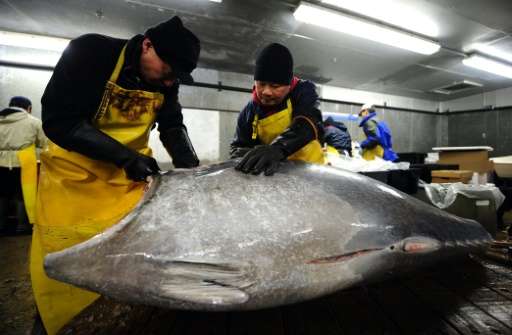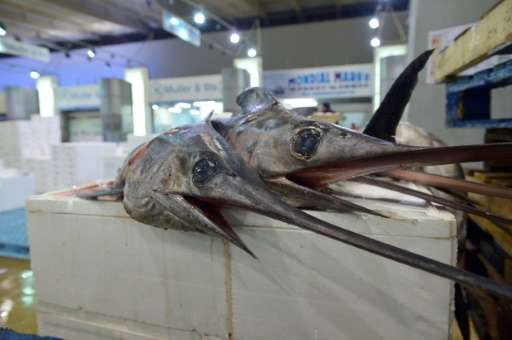Conservation meeting mulls fate of bluefin, swordfish

Fishing and shipping nations gather in Portugal next week to consider the fate of the endangered Atlantic bluefin tuna and overharvested Mediterranean swordfish, two pricey gourmet favourites.
While conservationists want stricter protection of these and other species, some member nations of the International Commission for the Conservation of Atlantic Tunas (ICCAT) are seeking bigger fishing allowances.
Representatives of the body's 51 parties—50 countries and the EU bloc—will meet in the coastal town of Vilamoura for a week starting Monday.
"Additional actions are required if ICCAT is to achieve its mandate to sustainably manage the fish stocks and fisheries under its control," said the Pew Charitable Trusts, which advocates for nature conservation.
The ICCAT is responsible for conservation of tunas and related species in the Atlantic Ocean and adjacent seas, as well as creatures which get tangled up as by-catch in tuna fishing.
Two years ago, the commission's members decided on a 20 percent annual increase over three years in bluefin tuna quotas in the Mediterranean and eastern Atlantic, despite objections that evidence of stock recovery was sketchy.
The Atlantic bluefin, called Thunnus Thynnus by scientists, is the biggest tuna, growing up to four metres (13 feet) in length.

It is a highly sought-after and expensive delicacy, especially as sushi and sashimi in Asia—a single specimen has sold for more than $1.75 million (1.6 million euros), according to the WWF.
Europe does most of the fishing.
Atlantic bluefin tuna stocks were decimated to a low of 150,000 tonnes in the mid-2000s after a decade of quotas as high as 50,000 tonnes per year.
The fish spawn just once a year and do not reach reproductive maturity until they are eight to 12 years old, making their numbers vulnerable to overfishing.
With the aid of lower quotas, the spawning stock rebounded to 585,000 tonnes by 2013, nearly double the levels of the 1950s, according to ICCAT figures.
But conservationists point out the numbers are mere estimates, given that headcounts are very hard to do. And illegal fishing is a major problem, they say.
The ICCAT has raised the 2014 quota of 13,500 tonnes to 16,142 tonnes in 2015 and 19,296 in 2016.

The 2017 quota was provisionally set at 23,155 tonnes, but has to be reviewed after a new stock assessment due early next year.
Some states, including Spain, have called for increases to be discussed already at this year's meeting, according to Paulus Tak, an international ocean policy expert at Pew.
And Turkey has lodged a formal objection to the 2014 decision, which means it can set its own quotas.
Not reviewing quotas ahead of the 2017 assessment was "critical", said Tak, "in order to avoid jeopardising the recovery of the stock".
Swordfish, bigeye
Conservation groups are also rallying for better protection of the Mediterranean swordfish.
The species as a whole is not threatened, but its Mediterranean sub-group is "overfished", according to the International Union for the Conservation of Nature, which keeps a "Red List" of species that are endangered or at risk of becoming so.

"The Mediterranean swordfish stock is really in a bad condition," the WWF's Giuseppe Di Carlo told AFP ahead of the annual gathering.
"It has been overfished for the last 30 years and it is now getting urgent to put in place an ambitious recovery plan."
The Mediterranean stock has fallen an estimated two-thirds from 1985, and 70 percent of total catches were of immature fish—before they had a chance to reproduce.
"But there is currently no plan for the sustainable management of this stock," said Di Carlo.
Italy is the main taker of Mediterranean swordfish, followed by Morocco, Spain and Greece.
The commission will also be asked to consider the status of other species at risk, including the bigeye tuna—another favourite in sashimi.
"Although tuna do provide food and livelihoods for people, they are more than just seafood," said the WWF.
"Tuna are a top predator in the marine food chain, maintaining a balance in the ocean environment."
© 2016 AFP


















